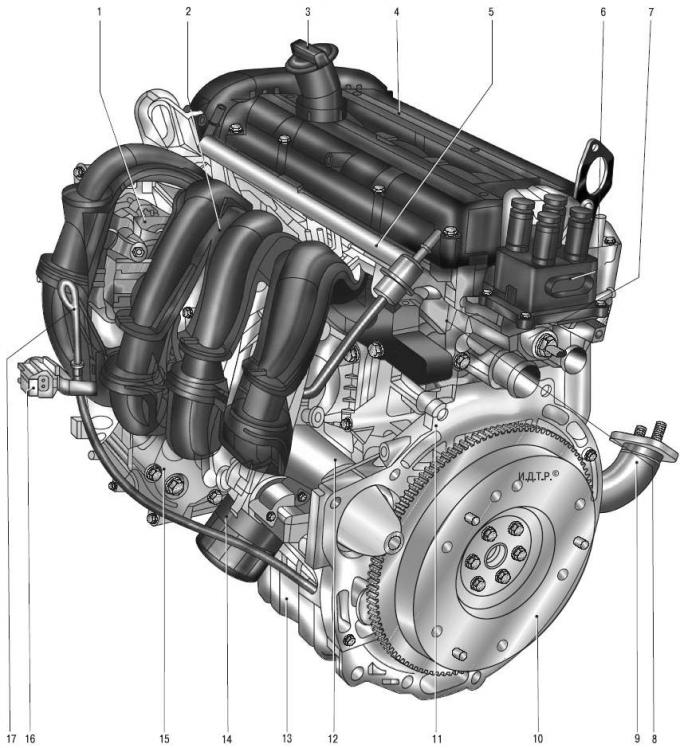
Pic. 5.1. Engine: 1 - generator; 2 - intake module; 3 - oil filler cap; 4 – a cover of a head of the block of cylinders; 5 - fuel rail; 6 - ignition coil; 7 - coolant temperature sensor; 8 – a head of the block of cylinders; 9 - collector; 10 - flywheel; 11 - cylinder block; 12 - starter; 13 - oil sump; 14 - oil filter; 15 - air conditioning compressor; 16 – block of a plait of wires of the fan of the engine cooling system; 17 - oil level indicator (oil dipstick)
Duratec 1.6 engine (pic. 5.1) with an overhead arrangement of two five-bearing camshafts, it has four valves for each cylinder. The camshafts are driven by a reinforced toothed belt. Belt tension is provided by a tension roller spring. The valves are driven directly from the camshafts through cylindrical tappets, which simultaneously serve as adjusting elements for clearances in the drive.
IN cylinder head, made of aluminum alloy according to the transverse cylinder purge pattern (inlet and outlet ports are located on opposite sides of the head), valve seats and valve guides are pressed in. The intake and exhaust valves have one spring each, fixed through the plate with two crackers. The head of the block is centered on the block with two bushings and attached with ten screws. A non-shrink metal-reinforced gasket is installed between the block and the head. In the upper part of the cylinder head, there are five bearing supports for two camshafts. The lower parts of the supports are made in one piece with the cylinder head, and the upper (lids) – attached to the head with screws. The holes of the supports are processed complete with covers, so the covers are not interchangeable and each of them has a serial number.
Cylinder block is a single casting of special high-strength cast iron, forming cylinders, a cooling jacket, the upper part of the crankcase and five crankshaft bearings made in the form of crankcase baffles. The cylinders are bored directly into the body of the block. In the lower part of the block, five beds of main bearings are made with removable covers bolted to the block. The main bearing caps are machined complete with the block and are not interchangeable. In beds of bearings (at the top of the supports) there are outlet holes of oil channels intended for lubrication of main bearings, as well as through holes into which ball valves with nozzles are pressed, through which oil is sprayed onto the piston bottoms and cylinder walls. On the cylinder block, special lugs, flanges and holes for fastening parts, assemblies and assemblies, as well as channels of the main oil line are made.
Crankshaft, made of high-strength cast iron, rotates in main bearings equipped with thin-walled steel liners with an anti-friction layer. The upper liners installed in the cylinder block have a groove on the inner surface and a through slot through which oil flows from the outlet of the oil channel to the ball valve with a nozzle. The bottom liners do not have grooves or slots. The axial movement of the crankshaft is limited by two identical thrust half rings. A flywheel is attached to the rear end of the crankshaft with six bolts. At the front end of the crankshaft, a timing gear drive pulley and an auxiliary drive pulley are installed.
Pistons with a short skirt are made of aluminum alloy. On the cylindrical surface of the piston head there are annular grooves for two compression and oil scraper rings. The oil scraper ring groove has six drillings to drain the oil removed by the ring from the cylinder walls. Two of these holes bring oil to the piston pin.
piston pins tubular sections are installed in the piston bosses with a gap and are pressed with an interference fit into the upper heads of the connecting rods, which are connected by their lower heads to the connecting rod journals of the crankshaft through thin-walled liners, the design of which is similar to the main liners.
connecting rods steel, forged, with an I-section rod. Connecting rods are processed complete with covers. In order not to confuse them during assembly, the serial number of the cylinder is applied to the side surfaces of the connecting rods and covers.
Camshafts cast, cast iron.
The gas distribution mechanism is closed with a plastic cylinder head cover. It has an oil separator for the crankcase ventilation system.
Lubrication system combined (see more details. «Lubrication system»).
From below, an oil sump cast from an aluminum alloy is attached to the cylinder block. The oil sump flange is sealed with sealant-gasket WSE-M4G323-A4. The crankcase has a hole with a threaded plug for draining the oil.
Oil filter full-flow, non-separable, with bypass and anti-drainage valves.
Crankcase ventilation system closed, forced, with removal of crankcase gases through the oil separator into the cavity of the air filter.
Cooling system sealed engine, with expansion tank (see more details. «Cooling system»).
Engine power system consists of an electric fuel pump installed in the fuel tank, a throttle assembly, a fine fuel filter and a fuel pressure regulator installed in the fuel pump module, a fuel pressure pulsation compensator, injectors and fuel lines, and also includes an air filter.
Ignition system microprocessor, consists of an ignition coil, high-voltage wires and spark plugs. The ignition coil is controlled by the electronic engine control unit. The ignition system during operation does not require maintenance and adjustment.
power unit (engine with gearbox, clutch and final drive) mounted on three supports with elastic rubber elements: two front ones, which take the bulk of the power unit, and a rear one, which compensates for the torque from the transmission and the load that occurs when the car starts, accelerates and brakes.
Visitor comments